Pteronophobia is the fear of feathers, feathered objects i.e., birds, or being tickled by feathers. As a turkey hunter I’ll go out on a limb and say turkey hunters aren’t likely to suffer the “fear of feathered objects” part of this affliction. Why? Aside from a turkey’s soul shaking gobble, its breathtakingly stunning plumage captivates us when a strutting spring gobbler’s sun-kissed feathers magically beam a kaleidoscope of colors declaring its majesty. Our hearts may skip a beat and breaths quicken, though not out of fear, but reverent gratitude. As you stroke the feathers of your next tagged turkey take a moment to contemplate the miracle of their perfection.
To better understand the form, function and maintenance of feathers important insight is included from wild turkey expert and researcher, Dr. Michael J. Chamberlain, PhD., Terrell Distinguished Professor of Wildlife Ecology and Management at Warnell School of Forestry and Natural Resources at the University of Georgia.
As Thanksgiving approaches many of us look forward to sitting down to a delicious turkey dinner. But have you ever wondered just how many feathers cover the body of a full grown turkey? In this article, we’ll explore the fascinating world of turkey feathers and uncover the answer to this plume-filled puzzle.
A Turkey’s Feathery Splendor
Turkeys are remarkable birds adorned with a stunning array of feathers. A full grown turkey possesses between 5000 to 6000 feathers! That’s right – thousands of intricately structured feathers coat the body of a mature turkey.
From the longitudinal stripes of black, brown, white, red, purple, green, copper and bronze that decorate their bodies, to the iridescent sheen glowing from their neatly ordered wing feathers, a turkey is a feathery work of art. Their plumage serves many crucial roles including insulation, communication, courtship displays, camouflage, and flight.
Feathers Provide Warmth and Protection
A turkey’s feathers provide excellent insulation to retain body heat and keep them warm. The base of each feather anchors into the skin while interlocking barbules on the feather’s vane create a cohesive surface to trap air close to the body. This layer of trapped air acts as effective insulation against cold temperatures.
The feather’s interlocking structure also allows turkeys to fluff their feathers during courtship displays or when feeling threatened By fluffing, they appear larger and able to ward off rivals or predators.
Feathers Enable Flight
While turkeys are not the strongest fliers, their wing feathers do enable short bursts of flight. Their primary and secondary flight feathers on the wings provide the needed lift and thrust to get their heavy bodies off the ground. Though domestic turkeys bred for meat have reduced flying capabilities, wild turkeys rely on flight to reach safe roosting spots in trees at night.
Feathers Play a Role in Courtship
The vibrant colors and unique patterns of turkey feathers assist in courtship displays. Toms (mature male turkeys) will puff up their body feathers, spread their colorful tail feathers like a fan, and drag their wings to entice hens (mature females). Even some hen turkeys adopt these courtship behaviors. The dramatic feather displays communicate fitness to potential mates.
Feathers Help With Camouflage
The barring and mottling patterns created by the stripes and varied colors on turkey feathers provide excellent camouflage. When turkeys are stationary on the forest floor, their feather patterns blend into the dappled light and shadows of the woods, concealing them from potential predators. Young turkey poults rely heavily on camouflage since they cannot fly well for the first few weeks of life.
Turkey Feather Facts
Now that we’ve covered some of the general functions of turkey feathers, let’s take a closer look at some fascinating turkey feather facts:
-
A turkey’s feathers are composed of the protein keratin, the same material found in human hair and fingernails.
-
Feathers grow symmetrically in paired groups from dots on the skin called feather follicles. An adult turkey has between 5,500 to 7,500 feather follicles.
-
Feathers are replaced regularly through molting. Adult turkeys molt once per year in late summer, replacing all their feathers over several months.
-
On average, a mature tom turkey has 18 to 20 tail feathers measuring up to 12 inches long. Hens have 10 to 14 shorter tail feathers.
-
9-10 of the primary wing feathers on each wing are specialized for flight and may reach 8 inches long in toms.
-
Downy feathers densely cover a turkey’s body beneath the outer contour feathers. They lack a central shaft, creating excellent insulation.
-
Turkey feathers feature central shafts (quills) with many branches called barbs extending off them. The barbs have tiny hooks that zip them together into a smooth vane surface.
-
Feather tips are unique to each turkey, allowing researchers to identify individual birds in the wild.
-
Male turkeys grow longer, more abundant feathers for their courtship displays compared to females. However, both sexes have similar total feather numbers.
-
Bright blue and red skin bumps called caruncles on a tom’s head are not feathers, but change color along with their head feathers during courtship.
-
Feathers make up around 6% of an adult turkey’s total body weight.
How Many Feathers Does a Turkey Have?
Now that we’ve covered some background on the structure and function of turkey feathers, let’s get to the key question – exactly how many feathers does a full grown turkey have?
A fully grown, mature wild or domesticated turkey has between 5,000 to 6,000 feathers covering their body. While the exact number may vary slightly between individual turkeys, this 5,000 to 6,000 feather range provides a reliable estimate.
Next time you sit down to your holiday turkey dinner, take a moment to appreciate the intricate plumage that once adorned your feathery centerpiece. While we humans may take our single layer of clothing for granted, be thankful the turkey comes pre-stuffed with its own built-in, feathered overcoat!
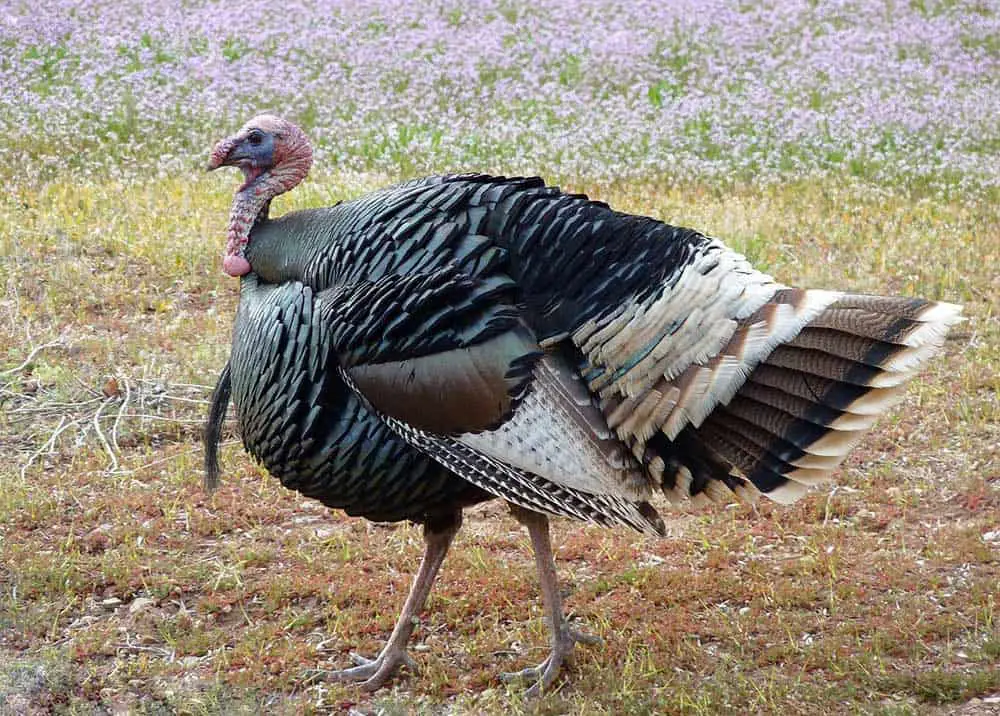
Turkey Feather Pigmentation and Iridescence Explained
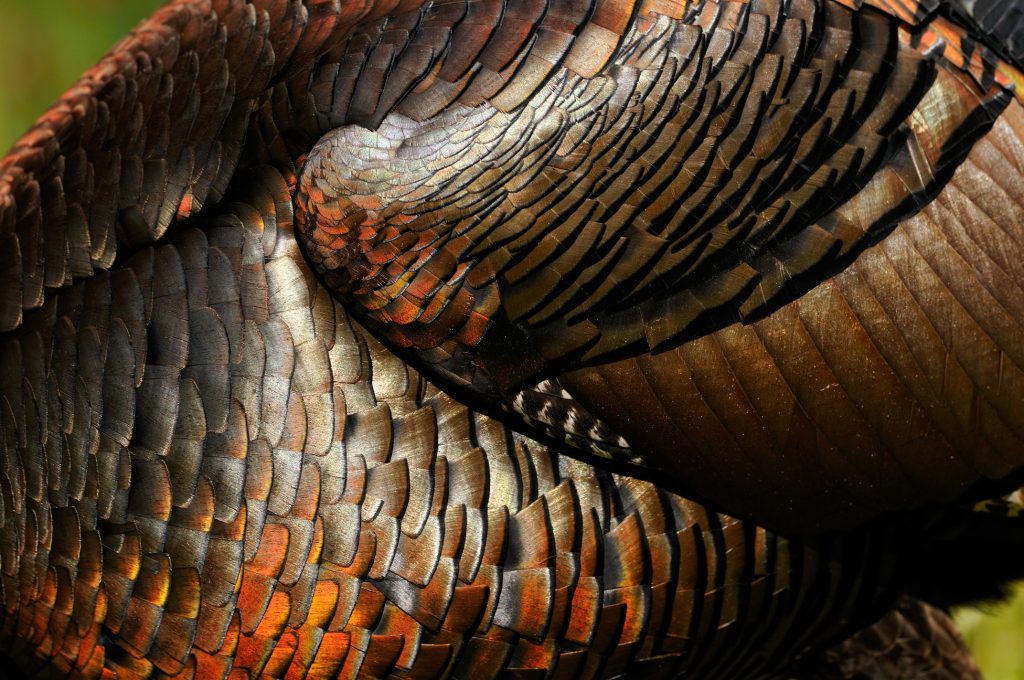
Colors in feathers are formed from pigments or from light refraction caused by the structure of the feather, or a combination of both. Pigments such as melanin are the colored substances found in turkey feathers. Melanin can produce colors from the darkest black to reddish browns and pale yellows. Color abnormalities occur when pigments are present or deficient at unusual levels such as in leucistic or melanistic color phases. Structural colors are produced by the structure of the feather as light is refracted. In wild turkeys, iridescence is caused by light refraction off the structure of the feather barbules.
Dr. Chamberlain: The brilliant colors are caused by light refracting off feathers, rather than feather colors. Crystals within the feathers block certain wavelengths of light but allow others to pass, which controls the intensity of colors. Iridescence which is the phenomenon where a surface appears to change colors as the angle of view changes, creates the brilliant shine that makes toms so stunning. Color and iridescence are an important part of the display toms use, and help hens determine the fittest tom in the breeding population.
Wild Turkey Feather Facts
Feathers serve in insulation, waterproofing, protection, concealment and recognition. A turkey’s 5,000 to 6,000 feathers are arranged in tracts, or pterylae. Feathers are composed mostly of keratin, a strong lightweight protein as in our hair and nails. The hollow base is the quill, or calamus. While the feather is growing blood vessels pass through it. The supply cuts off when it’s fully grown. The shaft, or rachis is the midrib extending through the feather’s center giving it stiffness and structure. Rising from both sides of the shaft are small, pigment-embedded structures called barbs. Tiny barbules branch off and lock the barbs together. Tinier hooked barbicels at the barbule’s end hold the feathers completely interlocked in a Velcro like manner. Together they form the soft and colorful vane. Feathers are layered like shingles giving the body shape and aerodynamics necessary for flight. A muscle controls each feather allowing it to move left or right, up or down, fluff or lay flat.
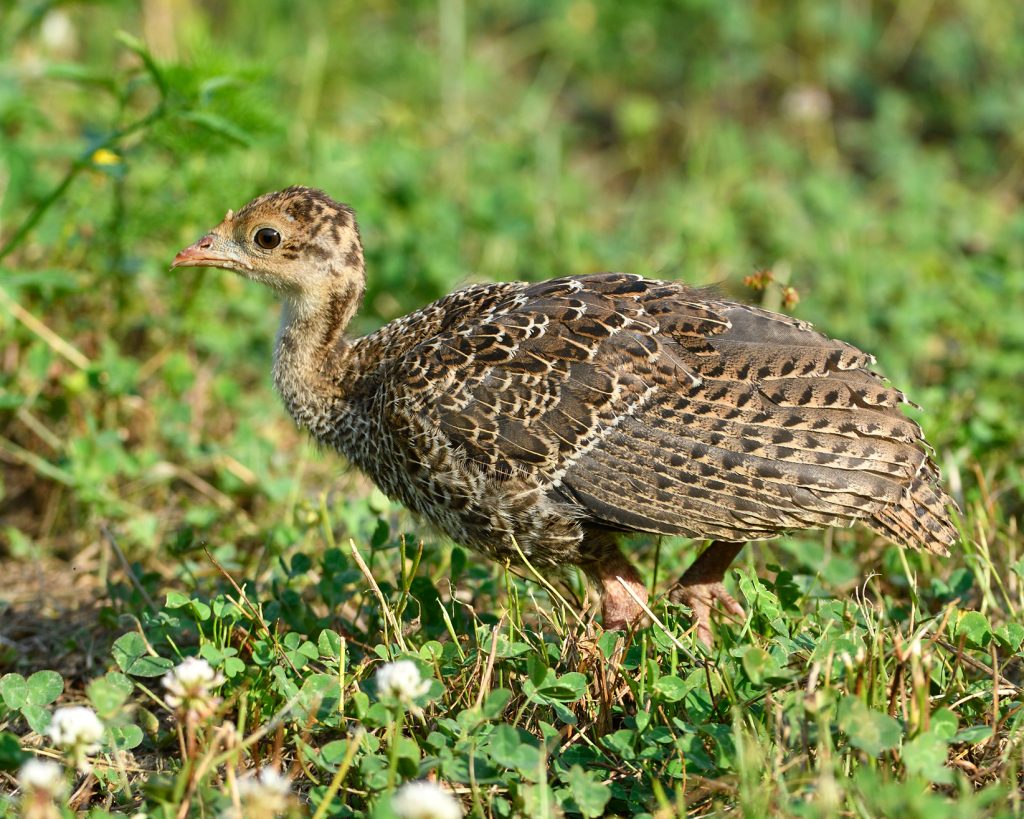
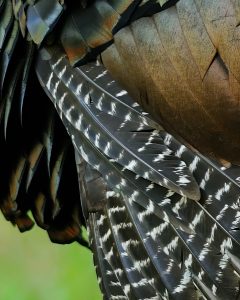
Primary feathers are the stiff, long feathers attached to the rump and wing. These include the typical 18 tail retrices, or fan feathers, which provide flight stability, steering and landing control for the heavy-bodied bird. During mating season, the colorfully displayed fan plays an important role in attracting hens and intimidating rivals. Tip colors in tail feathers and the covert feathers that cover their base vary with subspecies. Brown tips are characteristic of Osceolas, and Easterns. Rio Grandes have tan to buff tips and Merriam’s and Gould’s have whitish tips.
The ten black and white barred primary and 18 or 19 secondary flight feathers are called remiges. Extended, the primaries resemble outstretched fingers and have a long, slightly curved shaft with the vane narrower on the leading side than on the back. Shorter, wider secondaries support the primaries in their function. Specialized covert flight feathers overlay and protect the base of the wing feathers helping to shape them and provide warmth.
Dr. Chamberlain: Wing primaries are attached to the manus (the bird’s hand) and can be individually adjusted like fingers, offering agility in flight. The black and white barring is a way to age birds. Juveniles under a year-old lack barring at the ends of the outermost feathers. Toms use their primaries to draw attention while strutting. The feathers dragging the ground is distinctive to courtship displays. The amount of barring differs across the subspecies. Easterns have slightly more white than black barring, whereas Osceolas have little white barring which makes them appear almost black. Rio Grandes have wing barring that’s mostly equal black to white. Merriam’s and Gould’s have more white than black.
Contour, or body feathers give the bird its shape and colors. A tom’s contour feathers are typically dark with black tips while a hen’s are brownish or gray with
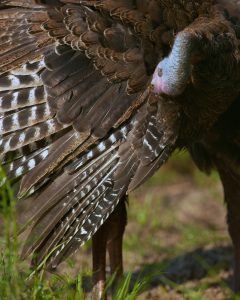
brown to light tips. Contour feathers are layered much like shingles in overlapping rows that form a protective waterproof layer that shields the body. Attached muscles allow the feathers to be held tightly against the body in warm temperatures or fluffed in cold weather to trap air for warmth.
Bristle feathers are hair like feathers that function as sensory tools and grow on the turkey’s head and neck. They’re well developed on hens as shown.
Dr. Chamberlain: We don’t know a ton about bristle feathers although they’ve been studied in other birds. I believe the ones that shield the ear are also bristle feathers, which makes sense because I suspect those feathers assist with sound to the ear and aid the bird in determining directions of sounds. I don’t know that, just a suspicion on my part. The beard is different than the bristle feathers, in that it’s a modified feather that serves primarily in mate attraction (and we believe) status amongst males but similar to other things with turkeys, we really lack an understanding of what all the beard does.
Down feathers, the soft, fluffy white feathers that grow close to the turkey’s body provide excellent insulation by trapping air between the body and the contour feathers. Poults are covered in natal down at hatching, which is rapidly replaced with juvenile feathers.
How many feathers does a turkey have?
FAQ
How many feathers are on a full grown turkey?
According to the National Turkey Federation, it’s estimated that turkeys have 3,500 feathers at maturity.
What are 5 interesting facts about turkeys?
- Turkeys are fast. …
- They roost in trees at night. …
- Turkeys are large. …
- Wild turkeys are omnivorous. …
- Their distinctive features help to express emotion. …
- An adult turkey has 5,000 – 6,000 feathers. …
- Turkeys were once threatened with extinction. …
- Turkeys have a better known fossil record than most birds.
What is it called when a turkey spreads its feathers?
- The turkey drops its wings so its primary wing feathers touch the ground
- It holds its tail vertically and fans its tail feathers
- It puffs out its back and breast feathers
- It changes its head and caruncle from blue to red or flesh tone
- It brings its head and neck down into an “s” shape
- It moves around to attract hens
How many feathers does a turkey tail have?
The tail fan averages 18 feathers but may be more or less. Feathers serve several survival functions – protection from the elements, camouflage, touch sensation, for flight and ornamentation when attracting the opposite sex. From poult to adulthood, turkeys go through four feather molts.
How many feathers does a Turkey have?
The number of tail feathers varies among turkeys, but they usually have between 12 and 18 feathers. 7. How long can a turkey’s feathers grow? The length of a turkey feather depends on its location. Tail feathers tend to be longer, measuring up to 12 inches, while the feathers on their bodies are generally shorter.
Do male and female turkeys have the same number of feathers?
Yes, both male and female turkeys have approximately the same number of feathers, although the males’ display feathers can be longer and more extravagant. 12.
How many tail feathers do you need to make a Turkey?
Seven tail feathers should work well on your turkey. 7. Next, you will trace the body parts of the turkey using the free printable template. Trace the body and the wings on brown cardstock, unless you want to use white cardstock and have your kids color the turkey.
How long are turkey wing feathers?
The average lengths typical of these four differing feather types are for female turkeys, as male turkeys have slightly shorter feathers: Wild turkey primary wing feathers can be 24-36 cm (9-14 inches) long. Image courtesy of fws.gov Body Feathers: Body feathers are the shortest on a turkey to provide a denser layer of insulation.
Do turkeys have tail feathers?
Tail Feathers: Turkey tail feathers can be surprisingly long and broad because they help the turkey steer itself when it flies. Yes, the turkey can fly well over shorter distances. The tip is usually a little broader than secondary wing feathers and often has a brighter tip followed by a thicker black patch.
What do turkey feathers look like?
Each turkey feather is unique, boasting vibrant shades of browns, blacks, and iridescent greens. They are essential for the bird’s survival, aiding in flight, insulation, and camouflage while perched on the forest floor. Interestingly, a turkey’s feathers are not limited to its body alone.
